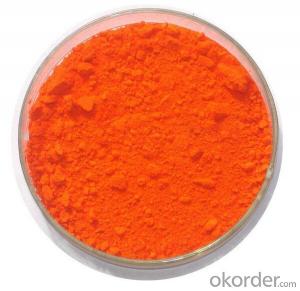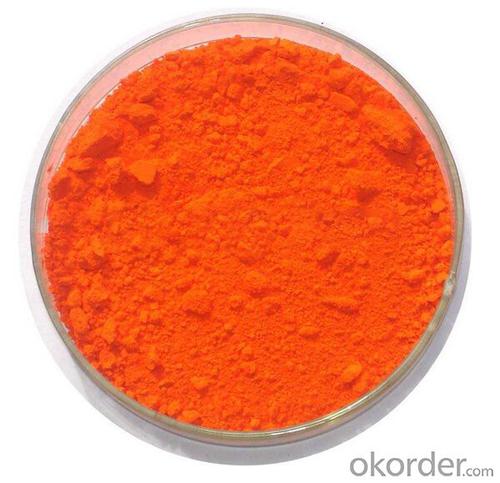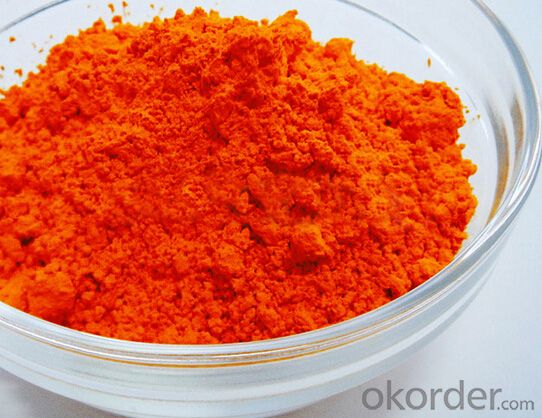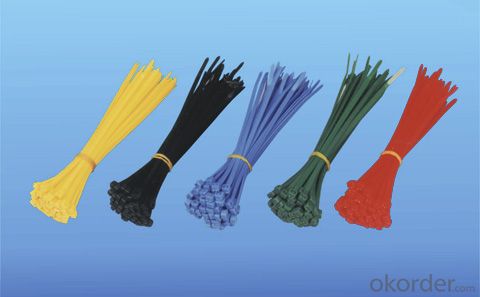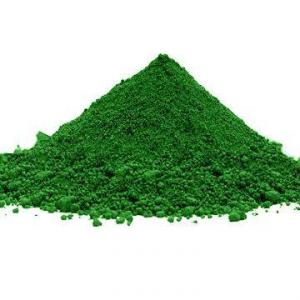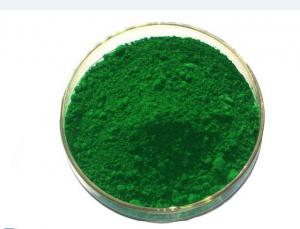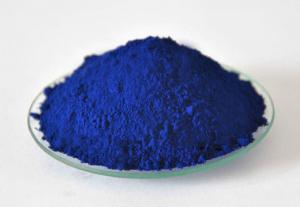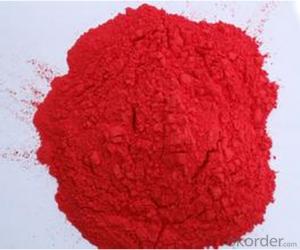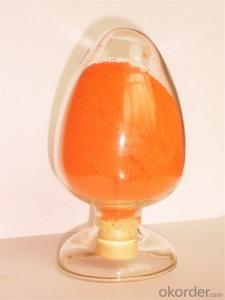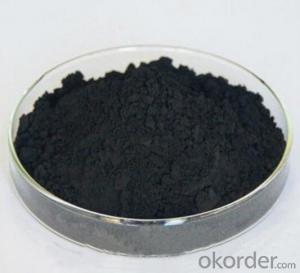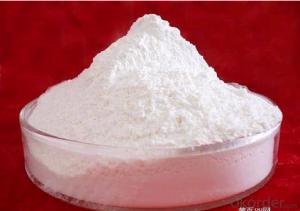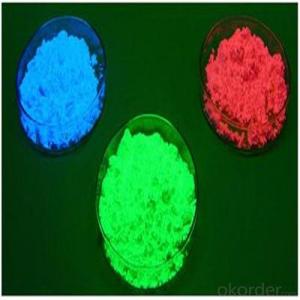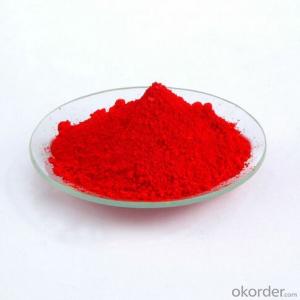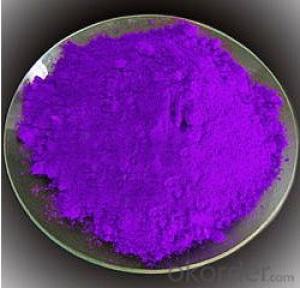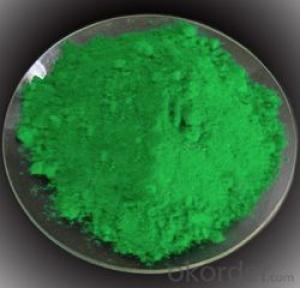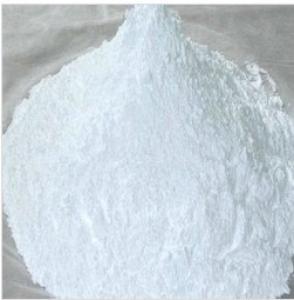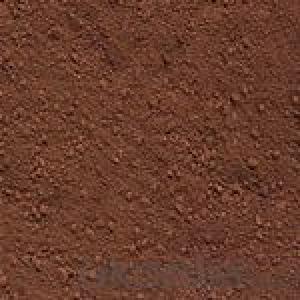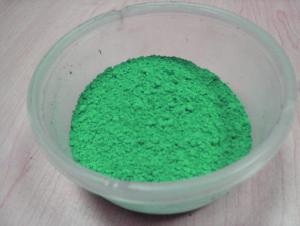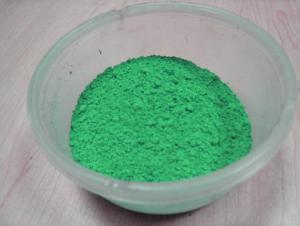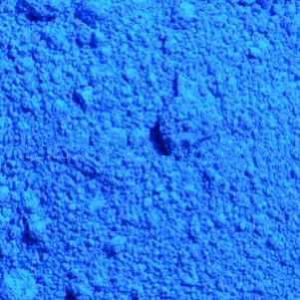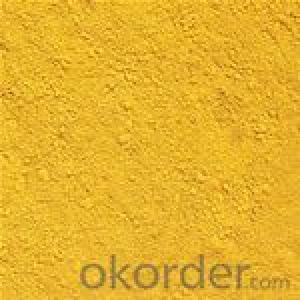Cadmium Orange Pigment Pigment Organic Powder
- Loading Port:
- Tianjin
- Payment Terms:
- TT OR LC
- Min Order Qty:
- 500 kg
- Supply Capability:
- 6000000 kg/month
OKorder Service Pledge
OKorder Financial Service
You Might Also Like
Cadmium Orange Specifications:
Products made by Powder Coating Pigments Manufacturer
- Excellent lightfastness resistance
- Weather resistance
- Tint strength
- Orange Pigment for Powder Description:
Chemical Name: Cadmium Orange
C.I.Name: Pigment orange 20
Chemical Components: Cd-Se-S
CAS No.: 12656-57-4
Cadmium Orange Main Technical Data:
Volatile content at 105℃: | ≤0.5% |
Soluble salts:
| ≤0.5% |
Residue on 325 mesh sieve: | ≤0.5% |
Features | The inclusion series is a kind of unpolluted pigment, compared with traditional Se. Red pigment, which is heat-resistant and high-colored. |
Usage | Mainly used in Tiles, Sanitary and Daily Ceramic producing, Offset Ink, Water base Ink , Textile Printing, Plastic etc.
|
Packing Details | 25kg/bag, 40bag/pallet, woven bag with inner plastic, or customized.
|
Delivery Time | 1-2 weeks after the confirmed order
|
Payment Term | L/C, T/T |
Cadmium Orange Advantages:
Non-flammable, non-corrosive, non-explosive.
Excellent coloring strength, good lightfastness, weather resistance, excellent hiding power and non-migratory, its’ color range from yellow through orange to purple reddish orange.
Cadmium Orange Applications:
Coating: Wall Coating, Powder Coating
Plastics: Masterbatch ,Engineering Plastics, PVC
Ceramics
Glass
Rubber

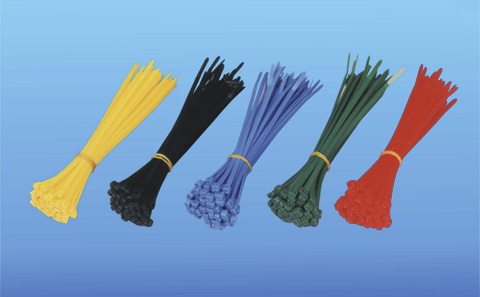

- Q: Why do algae contain pigments other than just chlorophyll?
- they stay underwater...the water swollows easy in a definite sequence, so the deeper they stay the greater distinctive is the easy and that they elect different pigments than landplants.
- Q: okay so I have always used all the cheap makeup and I am sick of it! I was wondering if mac pigments will give me a lot of color without having to use half of the container. Most eyeshadows look nothing like they are supposed to on me. they are like 100 times lighter. I have seen beautiful things done with the pigments but they look like they could get everywhere really easy. will they give me vibrant color without getting all over?
- Mac okorder it's only $0.99 a for either kind for .06 oz, you just need to use a eye primer for the best color results ( same as mac when using primer see you tube videos on NYX vs MAC pigments for proof). Plus cherryculture has numerous other makeup brands for dirt cheap. Hope this helps. Also all pigments should be applied with a slightly damp brush and a primer for the hugest impact. Used alone they are sheer and end up all over your face. If brush is dampened with no primer used on the eye they work ok but you get a lot of creasing, and it still won't be that dramatic look you are wanting. I realized this after major internet searching and trial and error, because I was upset I paid so much for the HIP pigment and it just wasn't staying put nor was it showing up. So again hope this helps.
- Q: What does pigment mean?
- The natural coloring matter
- Q: pretty self-explanatory...
- Pigments help in making food for the plants they also give color to it.Pigments are of different types which give different color to its leaves or fruits.Like mango is green first and then turns yellow coz green pigment is replaced by yellow pigment. Green pigment in most of the fruits is present only till it requires food and is raw.
- Q: what is the relationship between chlorophyll a, accessory pigment?
- Chlorophyll is the pigment that allows plants—including algae—to convert sunlight into organic compounds in the process of photosynthesis. Chlorophyll a is the predominant type found in algae and cyanobacteria (blue-green algae), and its abundance is a good indicator of the amount of algae present in the waters of the Chesapeake Bay. Excessive quantities of chlorophyll a can indicate the presence of algae blooms. These usually consist of a single species of algae, typically a species undesirable for fish and other predators to consume. Unconsumed algae sink to the bottom and decay, using up the oxygen required by other plants and benthic organisms to survive. The presence of too many nutrients, such as nitrogen and phosphorus, can stimulate algal blooms and result in reduced water clarity. Chlorophyll a also plays a direct role in reducing the amount of light avalable to plants in shallow-water habitats. This directly impacts the ability of underwater bay grasses to thrive. Like their terretrial cousins, grasses need sunlight to grow. As chlorophyll a levels increase, the amount of sunlight reaching underwater grasses declines. Chlorophyll a is the main pigment, chlorophyll b and carotenoids are accessory pigments. accessory pigments help broaden the absorbtion spectrum, as chlorophyll a absorbs violet-blue and red light. with the addition of accessory pigments chlorophyll b and carotenoids, yellow-green (chlor b) and violet and blue-green light (caro)
- Q: My wife went to the eye doctor to get new glasses (because she couldn't renew her driver's license with her glasses she had been using), and the doctor said that she wasquot;losing pigment" in both of her eyes. He said not to worry, but he wants her to make an appointment every 6 months, instead of just once a year.What does it (her losing pigment in her eyes) mean? Is it really nothing to worry about?(My wife doesn't seem worried, she hates going to doctor's but she trusts them when she goes to them; she doesn't ask questions-- she feels that if she needed to know something the doctor would tell her.)
- Yes, pigment is what gives your eyes color like Insanity said. It has nothing to do with the cornea becoming cloudy or going blind. In fact, it shouldn't affect her vision at all. The reason that the doctor wants to see her often is probably because as the pigment comes off the iris, it flows through the ocular fluid. This fluid follows a certain course through the eye and leaves through something called the trabecular meshwork, kind of like a filter or strainer. The pigment can block this meshwork, causing the pressure in the eye to increase, which can damage the eye. The pigment would have to build up before this happened, though, so don't worry about this happening over night or something. As long as the doctor is checking up on her, I'm sure she will be fine, so make sure she goes in for those checkups. For more information, look up Pigment Dispersion Syndrome.
- Q: i bought the new neon pro pigments from mac , well 5 out of the six and i also bought 'basic red'i want to use these as eye shadows but i dont know howi also bought mac mixing medium for face and body but lol , i dont know how to use any of this stuffwhat can i do to use this stuff i mean will it turn out like regular eyeshadow if i use it right? will there be a shine to it? it will reduce fall out? should i put the mixing medium on my eye first , then let dry?do i need to possibly press the pigments in a pot with some kind of eye shadow liquid?i also bought the mascara mixing medium but want to know exactly what to do with thatand also , can i mix any of the pigments with lipgloss?http://cn1.kaboodle /hi/img/2/0/0/119/a/AAAAAlrx1LUAAAAAARmgiA.jpg
- For MAC pigments you need a thick natural base underneath them to make them hold, and shine amazingly... I use paint pot base. Use a stiff eye brush and dab it in the pigment container. before applying it on your eye, shake off the access of it. make sure you have a base underneath though!
- Q: i want to get mac melon pigment but i dont know what other eyeshadows to pair and blend it with. im looking for an everyday look. also what brushes to use with pigments?
- With the Melon pigment, I would recommend using warm, chocolate copper, bronze types of colors. It will provide a nice contrast to the melon while giving your eyes some added depth and definition. As far as brushes go, I like using the 252, large shader brush. This brush picks up pigment nicely and it has nice compressed/dense bristles so you can manipulate and lay the pigment down with greater ease. I like the #286 The dual fiber blending brush for pigments as well. It's made of natural fiber and synthetic fiber. This is a great brush because you really get 2 brushes in 1. With this 'blending' brush you can also use it for targeted color deposits and the synthetic fibers won't suck up what you just laid down and you will get a flawless, beautifully blended eyeshadow application.
- Q: pigment: its color (to our eyes) what color of light it absorbsChl a Chl bCartenoidsany right answers would bbe greatly appreicated thanks soo muchhh
- pigment: .... reflected color to eyes .. what color of light it absorbs Chl a reflects green spectra between the blue and red absorption peaks. Some is absorbed at blue 450nm but most absorbed at red 680 - 700nm. Chl b reflects green spectra between the blue and red absorption peaks with a difference in which peak is stronger. Most is absorbed at blue 470 but also some at blue 430 and red 640 nm. Cartenoids reflect yellow, orange, or red and absorbs blue to blue-green light spectra. Xanthophyll absorbs well at 400-530 nm. Xanthophylls are a common sub class of the carotenoid pigment group. Beta-carotene absorbs most strongly between 400-500 nm.
- Q: i also need the color they are links would be great if you know a good one
- anthocyanis Xanthocyanins These are the reds and yellows you see in the fall when the green leaves turn colors
Send your message to us
Cadmium Orange Pigment Pigment Organic Powder
- Loading Port:
- Tianjin
- Payment Terms:
- TT OR LC
- Min Order Qty:
- 500 kg
- Supply Capability:
- 6000000 kg/month
OKorder Service Pledge
OKorder Financial Service
Similar products
Hot products
Hot Searches
Related keywords
